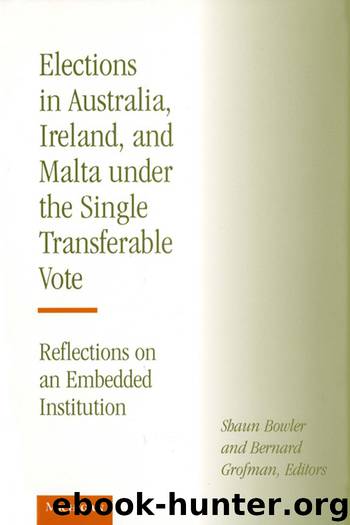Elections in Australia, Ireland, and Malta under the Single Transferable Vote by Shaun Bowler & Bernard Grofman

Author:Shaun Bowler & Bernard Grofman
Language: eng
Format: epub
ISBN: 9780472026814
Publisher: The University of Michigan Press
Fig. 1. Party C is at the median in a four-party, 99-seat legislature
In this particular example, Party D will just want at least one more seat and will not care where it comes from. Having won the seat and captured the median position by virtue of having a legislative majority, Party D need not take the positions of the other parties into account at all. If Party D does not win extra seats and provided that its support does not collapse, then Party C will be at the median, and this will be by far the most salient factor for Party D supporters. They might as well allocate lower preferences to Party C, as insurance against a decline in Party D’s seat total that was large enough to put the median position of Party C under pressure.
At the other end of the spectrum, Party A supporters have an incentive to allocate second and lower preferences to avoid the worst thing in the world for them, which is for Party D to win extra seats and take control of the government. Having done everything they can to help Party A win seats, second preferences should be allocated to help whichever of Party B or Party C appears most likely to lose a seat to Party D. An equivalent set of incentives will face the supporters of Party B.
The particular example shown in figure 1 has a near-majority party. In this event, the incentives of the other parties to use second and lower preferences to thwart the near-majority party’s quest for a majority look rather similar to those in a pure office-seeking government formation process. The reasoning behind the vote is quite different, however. With office-driven government formation, the danger is that the majority party will have no reason to share the spoils. With policy-driven government formation, the danger is that the majority party will, by definition, control the median legislator and therefore be able to determine government policy.
The interesting general conclusion in either case, however, is that whether it is office or policy that motivates politicians, the strategic incentives for supporters of the smaller parties will be to keep lower-preference votes away from a near-majority party. A corollary of this is that when there is a near-majority party, vote transfers among the other parties need imply no other affinity than a mutual desire to prevent the largest party from achieving majority status.
Taken together, this implies that in a party system in which there is a near-majority party, the strategic incentives deriving from postelectoral government formation imply a pattern in lower-preference allocation that makes an STV election look like a contest between the largest party and the rest.
When there is no near-majority party, there are likely to be two or three smaller parties contesting for the position of median party. These parties will presumably have incentives to allocate second-preference votes well away from their rivals for the median position. Other parties will have incentive to allocate lower preferences so as to help the median contender closest to their own ideal policy position.
Download
This site does not store any files on its server. We only index and link to content provided by other sites. Please contact the content providers to delete copyright contents if any and email us, we'll remove relevant links or contents immediately.
American Kingpin by Nick Bilton(3510)
Future Crimes by Marc Goodman(3374)
The Meaning of the Library by unknow(2386)
Inside the Middle East by Avi Melamed(2233)
Why Nations Fail: The Origins of Power, Prosperity, and Poverty by Daron Acemoglu & James Robinson(2176)
On Tyranny by Timothy Snyder(2127)
Living Silence in Burma by Christina Fink(1981)
Putin's Labyrinth(1902)
The Mastermind by Evan Ratliff(1830)
The Smartest Kids in the World by Amanda Ripley(1686)
Think Like a Rocket Scientist by Ozan Varol(1676)
Law: A Very Short Introduction by Raymond Wacks(1635)
It's Our Turn to Eat by Michela Wrong(1593)
The Rule of Law by Bingham Tom(1591)
Leadership by Doris Kearns Goodwin(1563)
A Dirty War by Anna Politkovskaya(1542)
Philosophy of law a very short introduction by Raymond Wacks(1541)
Social Media Law in a Nutshell by Ryan Garcia & Thaddeus A Hoffmeister(1451)
Civil Procedure (Aspen Casebooks) by Stephen C. Yeazell(1440)
